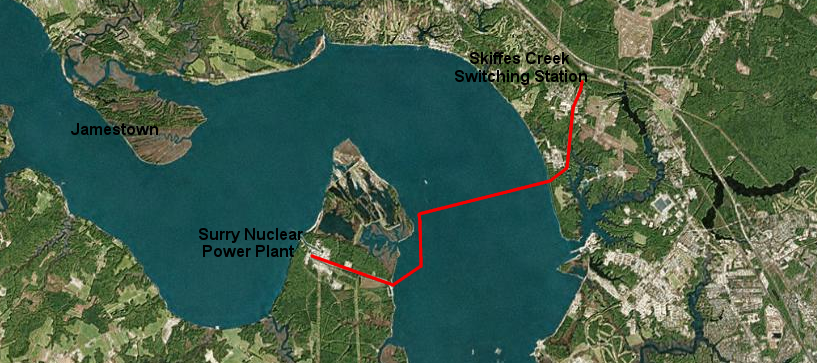
the 500kV powerline was located seven miles downstream from the 1607 fort at Jamestown
Source: ESRI, ArcGIS Online
Note: powerline route from US Army Corps of Engineers Application NAO-2012-00080, Project Location Map

the 500kV powerline was located seven miles downstream from the 1607 fort at Jamestown
Source: ESRI, ArcGIS Online
Note: powerline route from US Army Corps of Engineers Application NAO-2012-00080, Project Location Map
The scenic vista from Jamestown, looking over the James River, is part of the historic landscape. In 2007, the 400th anniversary of the first English settlement at Jamestown, the US House of Representatives passed a resolution that:1
The challenge of "protecting and restoring the James River" became clear just five years later. In 2012, the largest utility in Virginia proposed to alter the landscape with a major new powerline across the river. It would not be visible from the site of the 1607 fort, but would be within the viewshed of Jamestown Island, the Colonial Parkway, and Carter's Grove Plantation.
In 2013, Virginia's State Corporation Commission approved Dominion Power's plan to construct 17 towers in the James River downstream from Jamestown and attach a new high-voltage transmission line. The towers were part of an 8-mile 500kV line, including a 4.1-mile crossing of the James River, to link the nuclear power plant at Surry to the grid on the Peninsula at Skiffes Creek. Dominion would also build an additional 20 miles of an existing 230kV line, extending southeast from Skiffes Creek to the city of Hampton.
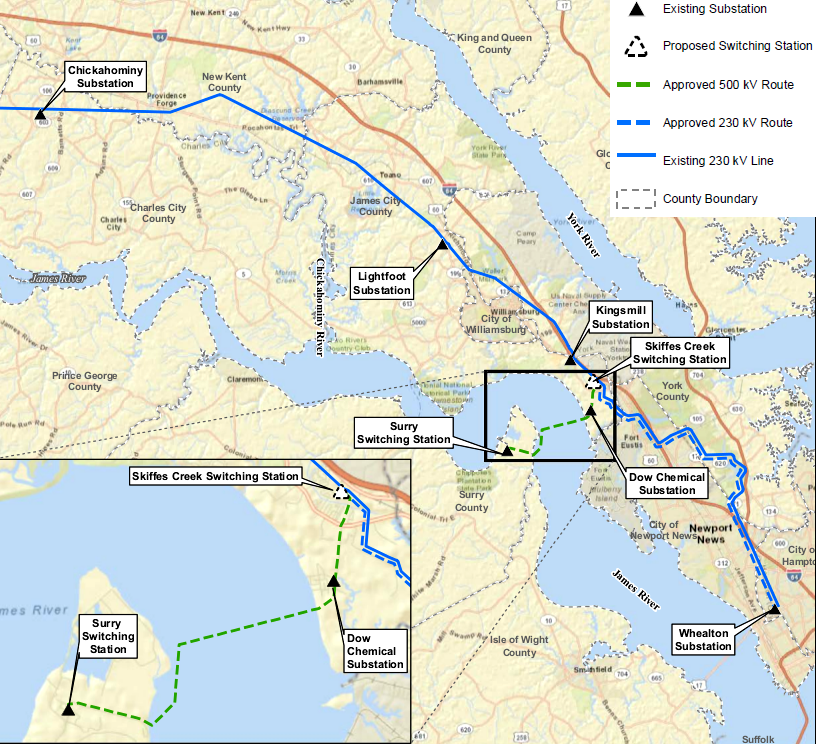
the powerline project includes a 500kV crossing of the James River from the nuclear power plant at Surry to Skiffes Creek, and an extension of the existing 230kV line down the Peninsula to Hampton
Source: Dominion Power, SCC approved route map
Though the shoreline is relatively undeveloped, it is not pristine. The state agency determined that reliable electrical service on the Peninsula was a higher priority than protecting the scenic vista or cultural landscape. Dominion Power completed the Skiffes Creek powerlines across the James River in 2018.
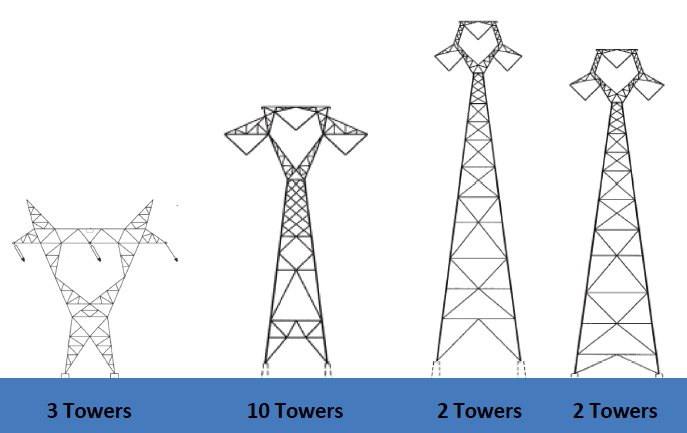
the tallest of the 17 towers across the river would be 295' high
Source: National Park Service, Overview: Proposed Surry-Skiffes Creek Power Line Project over the James River in Virginia's Historic Triangle
Four of the towers with the 500kV line crossing the James River are nearly 300 feet high, topped with flashing red lights. That is tall enough so all ships could pass safely underneath the powerline, but also tall enough to affect the scenic view.


according to Dominion Power's simulation, 300' high towers across the James River would have minimal impact on the scenic view from Jamestown
Source: Dominion Power, Simulations for the proposed Surry-Skiffes Creek 500kV route: East End of Jamestown Island

the powerline route runs closer to historic Carter's Grove, and would have obvious impacts on the vista there
Source: Dominion Power, Simulations for the proposed Surry-Skiffes Creek 500kV route: Carter's Grove
Dominion stated the new powerline was needed because the utility was retiring the last generating units at the Yorktown Power Station, coal-fired Yorktown Units 1 and 2 and oil-fired Yorktown Unit 3, to meet air quality standards under the Mercury and Air Toxics Standards (MATS) rule. Without the generating capacity provided by that power plant when demand peaks, the electrical grid on the Peninsula could not meet standards for providing reliable service in the North Hampton Roads Load Area.
With the retirement of Yorktown, 98% of the electricity used on the Peninsula comes from generating units located west of Richmond. The electricity down the Peninsula is carried by four 230kV transmission lines; there was no 500kV line into the region until the Skiffes Creek line was completed.
Dominion characterized the area east of Williamsburg as a weak link in the grid, and the only large population center in the state not connected to the 500kV transmission backbone. Without a better connection to distant generation plants, the utility anticipated rolling blackouts with up to 25% of customers being affected by "load shedding." If there was an unplanted generating plant outage or failure of a powerline:2
Dominion needed approval from the State Corporation Commission, which regulates investor-owned utilities, approves rates charged to customers, and ensures major new projects are cost-effective. In return, the utility is granted a monopoly to serve a particular geographic area, and is protected from competition within that service area.
Dominion also needed approval for the Skiffes Creek powerline from the US Army Corps of Engineers, because the 17 towers were a potential threat to navigation on the James River. The Federal permit required compliance with the National Environmental Policy Act (NEPA), Section 106 of the National Historic Preservation Act. Section 106 requires consultation with parties interested in historic preservation, but does not require reaching a consensus or compromise agreement:3
In addition to state and Federal approval, Dominion needed the local government to modify the zoning for the Skiffes Creek Switching Station. The utility needed to work with three layers of government, with three different approval processes, to get the Skiffes Creek project approved.
Dominion had hoped to bypass the local approval layer. The State Corporation Commission ruled that expanding the Skiffes Creek substation was integral to the transmission line, and issued a certificate of approval that exempted the utility from the zoning requirements of James City County.
Then the Virginia Supreme Court ruled in 2015, in a 4-3 decision, that that there was a clear distinction between a switching station (subject to local zoning) and a transmission line (exempt from local zoning). The state controlled the decision process for routing powerlines, but the General Assembly had not given the State Corporation Commission authority to issue exemptions to local land use decisions:4
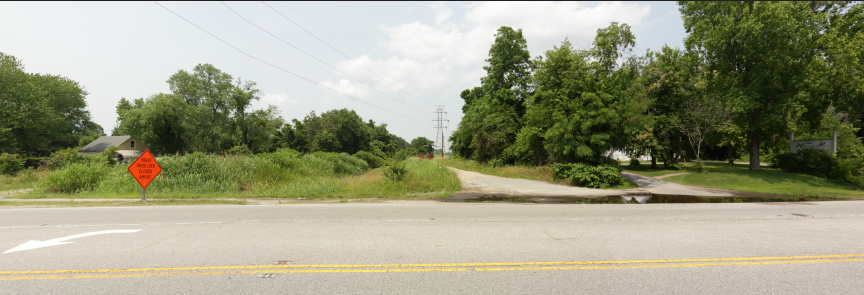
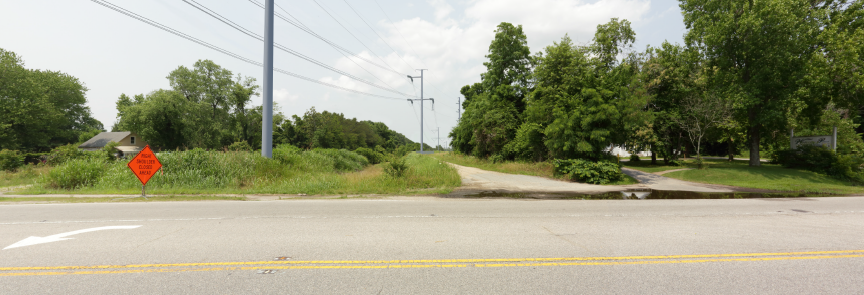
Dominion Energy simulated visual impacts in order to obtain government authorizations
Source: Dominion Energy, Skiffes Creek Switching Station - Visual Simulations
As a result, James City County retained the authority to approve/reject expansion of the substation. County supervisors postponed that Special Use Permit decision for 18 months until the end of 2016. The local officials knew that state had approved the powerline, but waited for the final reports from the Corps of Engineers. If the Federal agency had rejected the required permits for crossing the navigable river, there would have been no need for the county supervisors to make a controversial approval for the switching station associated with the powerline which they opposed.
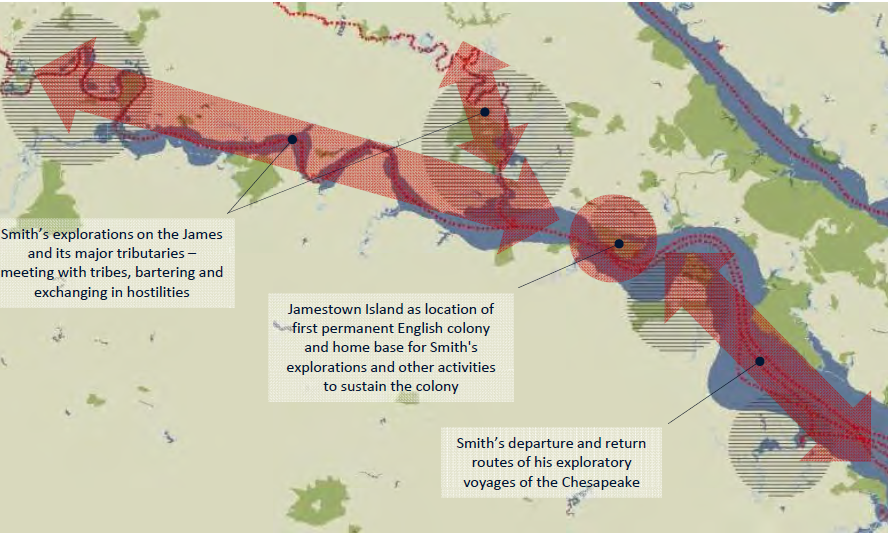
the National Park Service has defined major themes associated with John Smith's journeys on the James River
Source: National Park Service, Captain John Smith Chesapeake National Historic Trail, Making the Trail Visible and Visitor Ready: A Plan for the James River Segment
The James City County supervisors, Preservation Virginia, the National Trust for Historic Preservation, the Colonial Williamsburg Foundation, the National Park Service, and even the College of William and Mary opposed the project. They argued that preservation of the historic setting should receive priority. The utility should bury the transmission lines underground, or bring new powerlines down the Peninsula from Williamsburg rather than across the James River, or maintain electrical generation at Yorktown by retrofitting or repowering Yorktown with other fuel sources, or assume a different set of numbers for the demand for power.
Dominion responded that underground power lines would be "on the cutting edge of technology." The high-risk alternative would not ensure a dependable supply of electricity, and failure to meet reliability standards established by the North American Electric Reliability Corporation would expose Dominion to fines of up to $1 million/day.
In addition, an underwater powerline would cost five times as much. Burying the lines to protect the view would increase the project's cost from $60 million to over $300 million.5
opponents of the powerline, as well as Dominion, have simulated the potential impact on the scenic view
National Trust for Historic Preservation, 3D model of the proposed transmission towers crossing the James River at Jamestown
Dominion also rejected the suggestions of continuing to use oil-fired Yorktown Unit 3, or re-powering the Yorktown plant with natural gas. The utility calculated that a 620MW natural gas plant would be required, and the pipelines bringing gas to the Peninsula lacked capacity to supply it.
The inadequate gas pipeline capacity claim was asserted for the Peninsula north of the James River, but not for South Hampton Roads. In 2016 an independent company proposed to build a 1,400MW gas-fired power plant on the Elizabeth River. Matex Virginia Power LLC proposed to build the Great Bridge Energy Center next to the former coal-fired Chesapeake Energy Center closed in 2014 by Dominion Power. The new power plant would get its supply of natural gas from the Atlantic Coast Pipeline, in which Dominion was a majority owner.
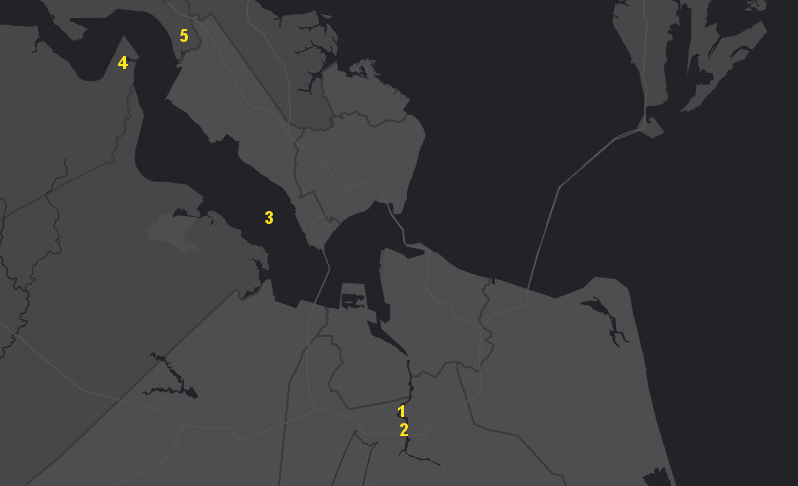
the proposed Great Bridge Energy Center (1)), just north of the now-closed Chesapeake Energy Center (2), included no proposal to increase transmission capacity across the James River at the James River Bridge (3) or between the Surry Nuclear Plant (4) and the Skiffes Creek substation (5)
Map Source: ESRI, ArcGIS Online
The new gas-fired power plant proposal on the Elizabeth River did not include any transmission lines to supply energy to the Peninsula. The Great Bridge Energy Center would sell its electricity into the PJM grid, and Dominion's network of power lines would distribute the electricity to South Hampton Roads customers. Placing a new generating facility south of the James River would offset the need to import electricity to Suffolk/Chesapeake/Norfolk/Virginia Beach from facilities west of Richmond. However, without transmission lines crossing the James River, a power plant on the Elizabeth River would not solve the reliability issues on the Peninsula.6
Also in 2016 another company, C4GT, proposed a 1,060MW power plant that would be fueled by natural gas and located in Charles City County, north of the James River. It too would be an independent "merchant" generation facility, not owned by the regulated utility and with the option of selling the electricity to customers in the PJM grid other than Dominion.
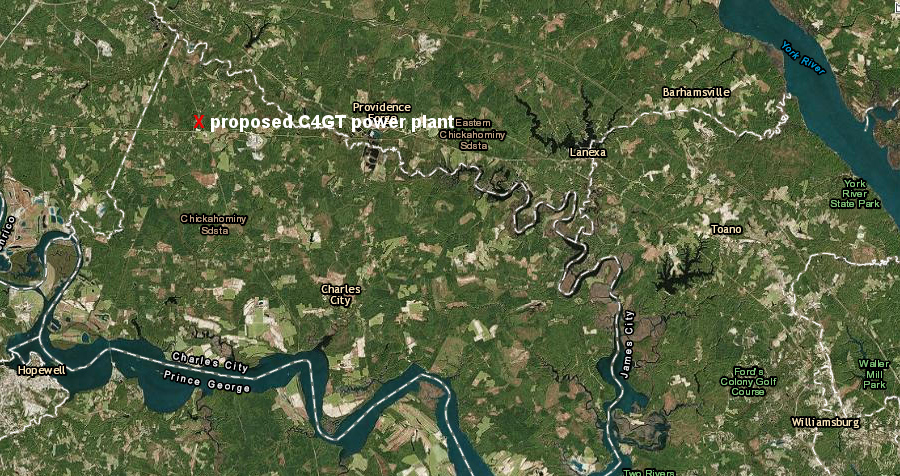
in 2016 C4GT proposed a 1,060MW electricity generating plant in Charles City County, using natural gas as the fuel
Map Source: ESRI, ArcGIS Online
Construction of that gas-fired power plant was delayed, but in 2019 a different independent company received state air quality permits for the 1,650MW Chickahominy Power Station in Charles City County. In contrast to Dominion's claims, both natural gas power plant proposals in Charles City County assumed there was adequate pipeline capacity to bring natural gas to the Peninsula. The Chickahominy Power Station would be Virginia's largest fossil fuel power plant, if constructed.
Investment in gas-fired power plants involves long-term risks. The cost of electricity generated by solar cells could drop below the cost of electricity generated by large facilities powered by fossil fuels, and potential improvements in battery storage could help solar power become more feasible. In 2018, independent electricity producer sPower proposed to construct a 340MW solar project on 2,270 acres in Charles City County. Like the gas-fired power plants, the solar proposal was also located near Virginia Power's Chickahominy substation.
James Bacon, a blogger with close ties to Dominion, noted that Dominion Power was proposing to spend $1.3 billion to build its own 1,600MW, gas-fired power plant in Greensville County. With other power companies proposing to build "merchant" plants which would compete in the marketplace to sell electricity, Bacon had already questioned the decision-making process of Dominion Power for ensuring reliable electricity supply at a fair cost to ratepayers:7
Solar-generated electricity was yet another potential supply on the Peninsula. Proposals to install solar panels to generate electricity might have an impact in the future, but Dominion claimed greater transmission capacity was required immediately, in order to meet reliability standards as soon as Yorktown Unit 1 and Unit 2 were retired.
To justify the Skiffes Creek line, Dominion cited the challenges faced by the US Navy to generate enough electricity from just solar facilities. The Navy started a 21MW solar farm on 100 acres at Oceana Naval Air Station in 2016, but Dominion said that over 13,000 acres covered with solar panels would be required to generate the 630MW needed to replace the electricity that would be transmitted by the 500kV Skiffes Creek powerline. The utility calculated that a solar farm must have the capacity to generate 1,630MW to supply 630MW, because generation from a solar facility was equivalent to only 38% of a fossil-fuel facility that could operate 24 hours/day.8
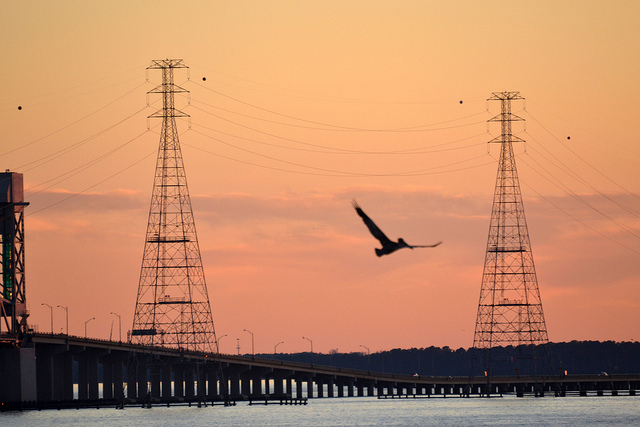
existing powerline towers at the James River Bridge, where US 17 crosses the river over 20 miles downstream from Jamestown
Source: Save the James Alliance, A Gallery of Blight
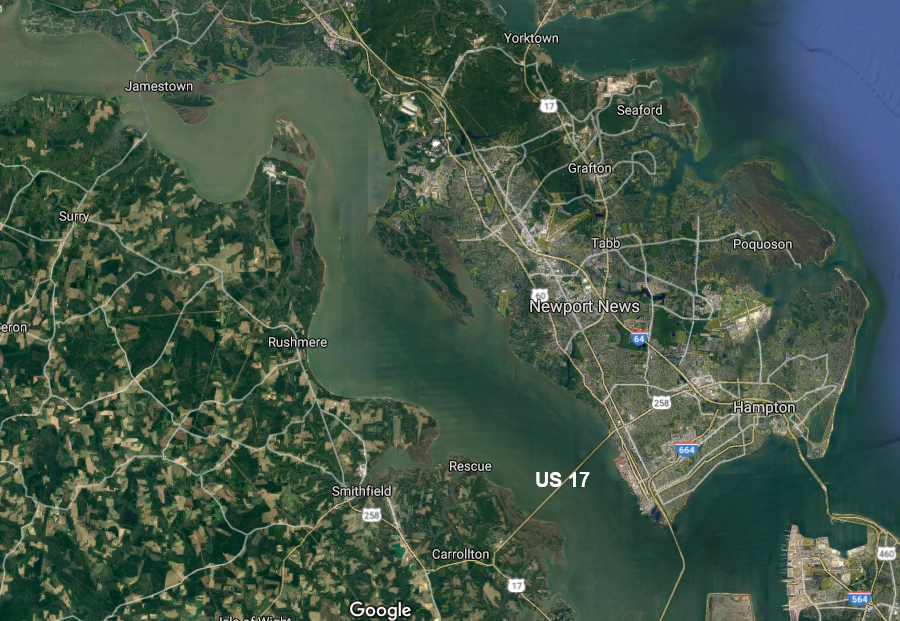
US 17 crosses the river far from the viewshed of Colonial Parkway and Jamestown Island
Source: Google Maps
Dominion rejected generating electricity on the Peninsula, and also rejected the alternative of building a new 500kV powerline across the James River further downstream below Fort Eustis. The flight path at Fort Eustis limited options just downstream from Skiffes Creek.9
Below Fort Eustis, two 230kV powerlines already parallel the James River Bridge which carries US 17 over the river. Rebuilding them to add a 500kV powerline there would have marginal additional impacts on the scenic vista, compared to building the line to Skiffes Creek and extending the existing 230kV line 20 miles down the spine of the Peninsula to the Whealton substation in Hampton.
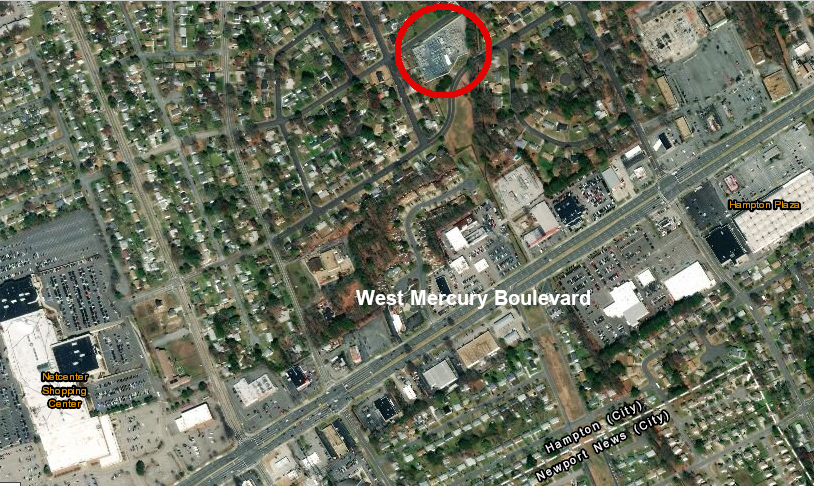
Dominion's 230kV powerline running down the Peninsula was extended to the Whealton substation (red circle) in Hampton
Source: ESRI, ArcGIS Online
Dominion rejected the James River Bridge alternative for multiple reasons. There was no excess capacity in South Hampton Roads at the James River Bridge area to transmit across the river to the Peninsula, compared to the availability of electricity at the Surry Nuclear Power Plant. Taking the existing 230kV lines out of service to upgrade to 500kV would cause a violation of transmission reliability standards during the rebuilding. Dominion claimed it might have to implement rolling blackouts up to 80 times annually to customers in Newport News, Hampton, and the lower tip of the Peninsula.
Dominion projected that associated transmission and generation upgrades to implement the National Trust for Historic Preservation proposals would cost $1 billion. The utility claimed that co-locating transmission lines would create a greater risk of an outage by a storm or shipping accident, compared to building a new line on a different route to Skiffes Creek.
PJM Interconnection, which manages the regional electrical grid, also rejected the alternatives proposed by the National Trust for Historic Preservation. PJM acknowledged in 2017 that it had over-estimated future demand, but said the new Skiffes Creek powerline was still required to provide reliable high voltage connections. The alternatives that required continued use of oil-fired Yorktown Unit 3 would not address unacceptable overheating of high voltage lines or voltage swings.10
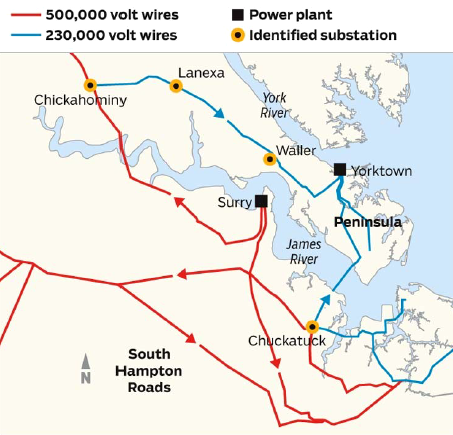
one alternative to connecting the Peninsula to the network of 500kv transmission lines was a link from Chuckatuck across the James River bridge, where US 17 crosses
Source: National Parks Conservation Association, Dominion's Proposed "Surry-Skiffes Creek Project" - Issues and Alternatives (Figure 1)
Dominion proposed a mitigation plan that would cost $85 million for a Skiffes Creek powerline with construction costs of $181 million. Opponents highlighted deficiencies, including an inadequate assessment of visual impacts. After the Advisory Council on Historic Preservation advised the Corps to examine the concerns, Dominion revised the viewshed analysis and mitigation plan without increasing projected project costs.11
The mitigation proposals did not create consensus. The National Trust for Historic Preservation put the James River on its 2016 list of most endangered historic sites in the United States.12
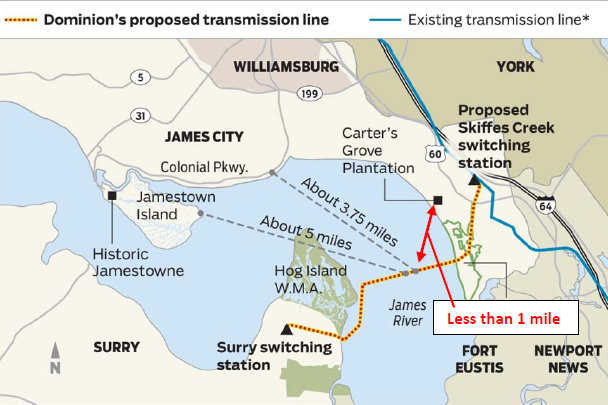
historic Carter's Grove would have its viewshed affected more than Jamestown
Source: National Parks Conservation Association, Dominion's Proposed "Surry-Skiffes Creek Project" - Issues and Alternatives (Figure 2)
The National Park Service still recommended that the Corps of Engineers deny the permit for the proposed overhead line, forcing Dominion to choose an alternative that did not include tall towers across the river. In 2016, the Director of the National Park Service was a native Virginian who traced his family back to the arrival of the English ship Diana in 1620. He argued that the long-term value of preserving the historic setting exceeded the short-term cost of an alternative to the Skiffes Creek powerline:13
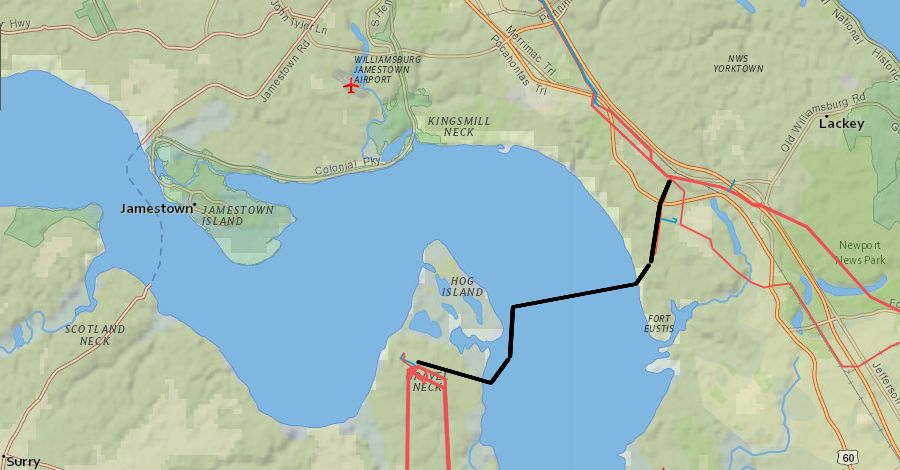
the 500kV powerline (black line) connects to an existing 230kV powerline at the Skiffes Creek substation
Source: ESRI, ArcGIS Online
The local National Park Service official, the superintendent for Colonial National Historical Park with responsibility for the Jamestown site, said that upgrading the gardens at Carter's Grove to offset the visual impact would not be sufficient:14
The Virginian-Pilot summarized the challenge for the Corps of Engineers:15
Consensus is not a requirement in the permitting process. Ideally, the Section 106 process established in the National Historic Preservation Act results in stakeholders agreeing on the appropriate levels of mitigation, and that compromise is documented in a Memorandum of Agreement among the parties.
If the Skiffes Creek project could not get to that point, then the Corps of Engineers had the choices of recommending that Dominion be required to complete a full Environmental Impact Statement (EIS) or terminating the negotiations. If terminated, then the Corps would provide information about the negotiations and a draft Memorandum of Understanding to the Advisory Council on Historic Preservation. The Advisory Council on Historic Preservation then has the obligation to comment back to the Corps, and the Corps would then make a final decision on the permit required by Dominion. The Corps had the authority to accept proposals or to reject the objections of the National Park Service and others to the overhead power line/towers.
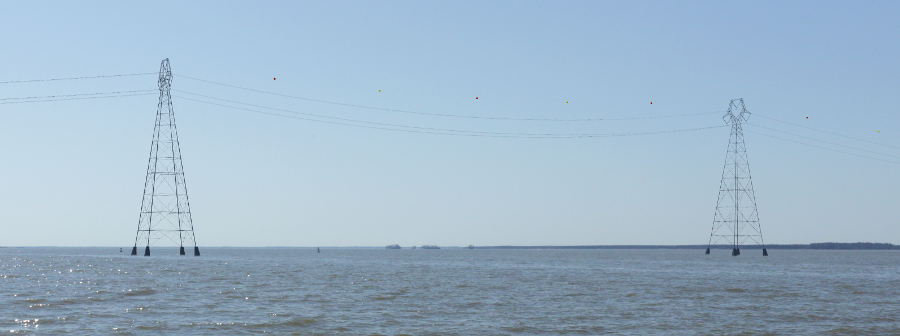
simulated powerline towers in the James River
Source: US Army Corps of Engineers, Dominion Power Surry-Skiffes Creek-Whealton Permit Application, Photo Simulations Overview (Viewpoint 05)
In 2017, a Section 106 agreement was finally reached and signed by Dominion and three public agencies, the Corps of Engineers, the Virginia Department of Historic Preservation, and the Federal government's Advisory Council on Historic Preservation. None of the consulting parties, such as the National Park Service, signed the agreement.
Dominion agreed to a slightly more expensive mitigation plan. Dominion projected that rolling blackouts could be avoided by using the oil-fueled generator at Yorktown when necessary.
The utility also agreed to donate $1.5 million to the Chickahominy tribe and $4.5 million to the Pamunkey tribe, plus donate the land including the spiritual site of Uttamusack to the Pamunkey tribe. That revised plan raised the anticipated mitigation costs from $85 million to $91 million:16
Shortly before signing the Section 106 agreement, Dominion Energy shut down the two coal-fired generating units at Yorktown as it had scheduled. In case of failure in a transmission line or unexpected demand exceeding transmission capacity, the utility planned to "shed load" to customers in small areas, using a "rolling blackout." The cuts in service were prepared to continue to deliver electricity to people with special needs, such as patients at home relying upon oxygen machines.
Dominion also prepared a Remedial Action Scheme (RAS). It would cut service automatically in a unplanned blackout extending to the tip of the Peninsula, and without accommodating people with special needs.
Dominion had initially claimed that rolling blackouts could be required 80 times annually, if the two coal-fired generating units were off-line and there was no Skiffes Creek powerline. The utility said that twice in the previous decade, the utility had experienced conditions that would have required cutting service to customers as planned in the Remedial Action Scheme. On May 20, 2018, an unexpectedly hot day caused demand to climb again to a point where the Remedial Action Scheme was "armed." Had demand increased slightly higher that day, computers would have acted automatically to cut electricity to 150,000 customers, including those with special needs.
The risk of implementing the Remedial Action Scheme (RAS) before completion of the Skiffes Creek powerline concerned regulators. In June, 2017, two months after the Section 106 agreement, the US Department of Energy granted a temporary exemption to the Mercury and Air Toxics Standards rule in order to allow continued use of the two coal-fired units at Yorktown. The exemption enabled Dominion to maintain sufficient generation capacity on the Peninsula in case a transmission line failed, and helped the PJM electrical distribution organization ensure reliable electricity service until completion of the Surry-Skiffes Creek Connector in two years.
In July, 2017, the US Army Corps of Engineers issued a final permit for the Skiffes Creek power line, authorizing construction of 17 towers in the James River and installation of the overhead line. In response, the National Parks Conservation Association, National Trust for Historic Preservation, and Preservation Virginia filed suits in Federal court. They argued that the Corps should prepare a full Environmental Impact Statement, rather than issue the permit based on the less-detailed analysis in an Environmental Assessment.17
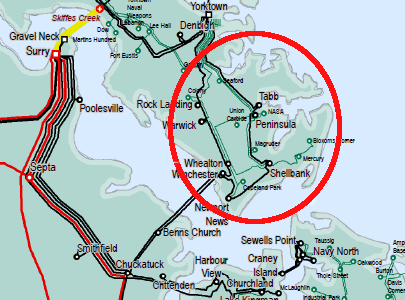
under Dominion's Remedial Action Scheme, 150,000 customers on the tip of the Peninsula could lose electricity if a transmission line fails
Source: Dominion Energy, New Remedial Action Scheme - North Hampton RAS
There was a similar powerline vs. scenic vista dispute near the mouth of the Rappahannock River. In 2015, Dominion Energy proposed a series of towers crossing the Rappahannock River to replace an existing overhead 115-kilovolt transmission line. The existing line paralleled and was attached in places to the Robert O. Norris Bridge, which links Middlesex and Lancaster counties.
Local residents advocated for an underground power line to protect the scenic view, noting that the Northern Neck depended upon tourism. Dominion claimed the costs to put the line underground, through either trenching in the riverbed or horizontal drilling, would be excessive.
In August 2017, the hearing examiner for the State Corporation Commission recommended in favor of the scenic view, stating:18
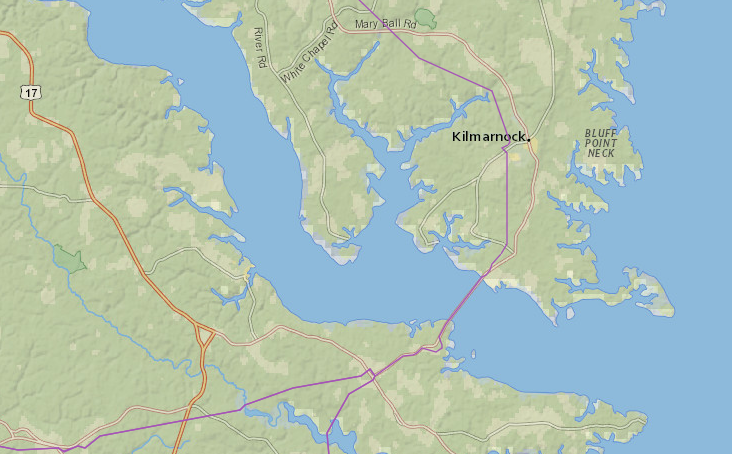
in 2017, the State Corporation Commission hearing examiner recommended that the transmission line crossing the Rappahannock River be placed underground in order to protect the scenic view
Source: ESRI, ArcGIS Online
The appeal of the National Parks Conservation Association and other over the Skiffes Creek powerline was resolved in May, 2018. A Federal judge rejected the request to block construction. He ruled that the Cultural Resources Effects Assessment (CREA) prepared by the Corps of Engineers was sufficient.
Some of mitigation funding provided by Dominion was used downstream at Yorktown to purchase 50 acres with traces of original earthworks and roads from both the Revolutionary War and the Civil War. That blocked a 100-home subdivision and added land to Colonial National Historical Park.19
The powerline was completed and energized on February 26, 2019. The six two-inch wide cables strung from the towers began to deliver 500,000-volts of electricity to the grid on the Peninsula, reducing the risk of a blackout. Dominion Energy then began shutting down the two coal-fired boilers at the Yorktown Power Plant.
Yorktown 1 had run for 62 years, and Yorktown 2 for 28 years. In their last two years of operation, they were no longer used to provide baseload power since the exemption from Federal air pollution rules had expired. They were started and stopped 100 times in 2017-2019 based on emergency orders to ensure adequate electricity when other transmission lines were out of service, or when high summer temperatures created a peak demand that transmission lines could not supply.
Maintaining the old equipment was challenging. At one point, a mothballed plant in Fluvanna County was cannibalized to provide a replacement fan.20
Energizing the new transmission line crossing the James River and shutting down Yorktown 1 and 2 did not end the dispute, however. On March 1, a three-judge panel of the U.S. Court of Appeals for the D.C. Circuit vacated the Corps of Engineers permit for the power line and 17 towers.
The judges unanimously reversed a 2018 ruling from the U.S. District Court for the District, which had allowed the Federal agency to issue a permit based on an Environmental Assessment (EA). The appeals court ruled that a full Environmental Impact Statement (EIS) was required.
The appeals court decision did not require Dominion Energy to stop transmission of electricity across the James River on the now-completed powerline, but did create the potential for another court ruling to "vacate" the Federal permit and require that the towers/powerline be removed. A Dominion official said:21
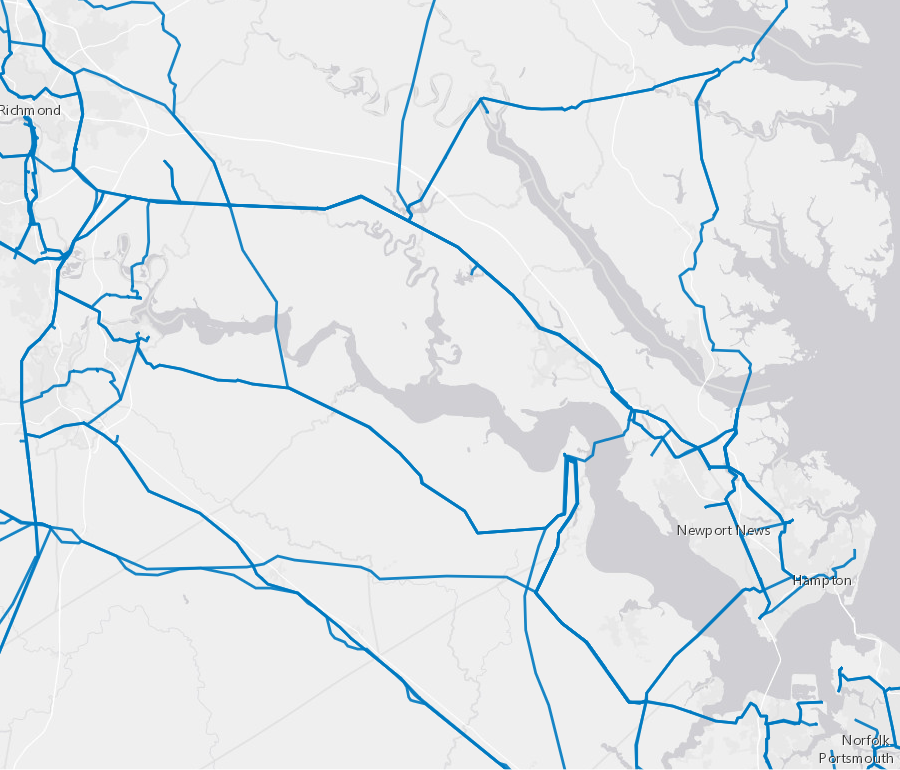
high voltage transmission lines bring electricity to the Peninsula
Source: Homeland Infrastructure Foundation Level Database - Department of Homeland Security, Electric Power Transmission Lines
The decision by the appeals court led to the Corps starting a full Environmental Impact Statement considering 27 alternatives to the transmission line, including its removal. Construction had cost $435 million; removal would cost another $46 million.
Normally an Environmental Impact Statement (EIS) is completed prior to construction, so an early decision by the Corps was whether or not to include the environmental impacts of removal (such as disturbance to fish and how emissions from tugboats would affect air quality) as a factor.
Circumstances had changed since the initial approval of the powerlines after completion of an Environmental Assessment (EA). The supervisors of Charles City County had approved sPower's 340-megawatt Keydet Solar Project in March, 2019. The 1,060 megawatt combined-cycle, gas-fired power plant proposed by C4GT was on hold, but the 1,650MW Chickahominy Power Station had received a key air quality permit and appeared headed for construction. Those facilities created an alternative source for electricity that did not require a transmission line crossing the James River.
Most importantly, however, those facilities had not been constructed while the coal-fired units at the Yorktown Power Plant had closed and no longer offered an alternative source of electricity on the Peninsula.
The appeals court decision created the potential for the plaintiffs to negotiate with Dominion Energy to end the legal dispute. Plaintiffs could choose to bargain for further financial support for mitigation of the impact on the scenic view, rather than removal of the already-installed towers and powerline.
As the US Army Corps of Engineers started to prepare a full Environmental Impact Statement, the U.S. Court of Appeals for the District of Columbia decided to return the case back to the D.C. District Court. The appeals court directed the judge whose decision they had overturned to decide if the Corp's permit to build the powerlines should be vacated. He decided to leave the permit in place. The judge ordered the Corps to complete the full Environmental Impact Statement, but his decision essentially eliminated the potential for the powerlines to be removed:22
In 2018, Dominion Energy had created another public debate over damage to a historic scenic vista. The utility company proposed building a gas compressor plant across the Potomac River from Mt. Vernon, in order to push more natural gas through its Cove Point pipeline. The exhaust stacks would be limited in height so trees would screen them, but neighbors objected to the increased pollution they would experience.
After objections from Mt. Vernon, Dominion Energy decided to move the compressor plant rather than extend the debate.23
The draft of a full Environmental Impact Statement for the Skiffes Creek powerlines, issued in 2020, examined 28 alternatives to the already-completed Skiffes Creek line. The Corps of Engineers concluded again that the best alternative was the route used for actual construction. The rejected alternatives required more natural gas than was available, would destroy too many homes or acres of wetlands, would not supply adequate power, or had other engineering and environmental impacts.24
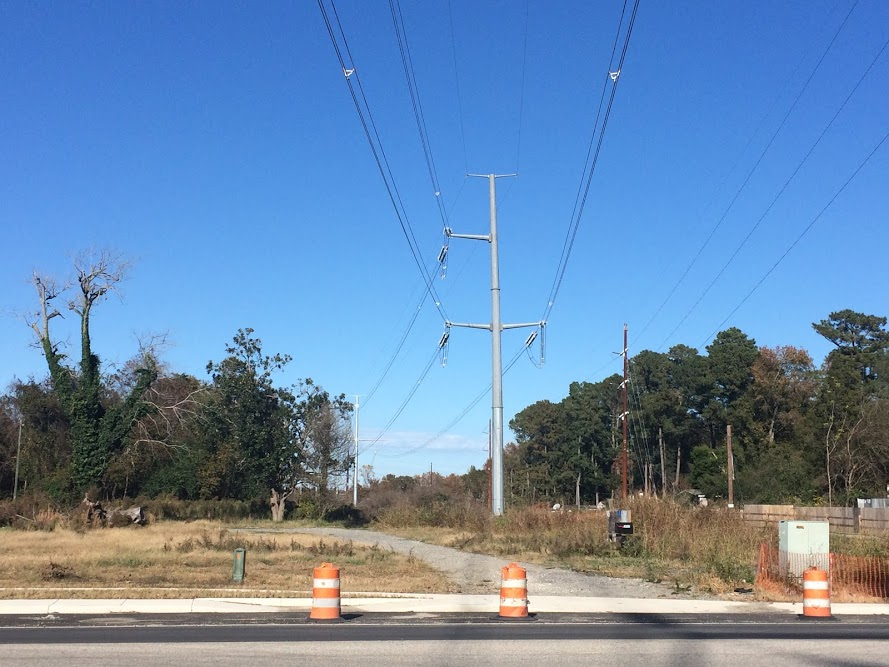
new powerline crossing US 60 in November, 2018
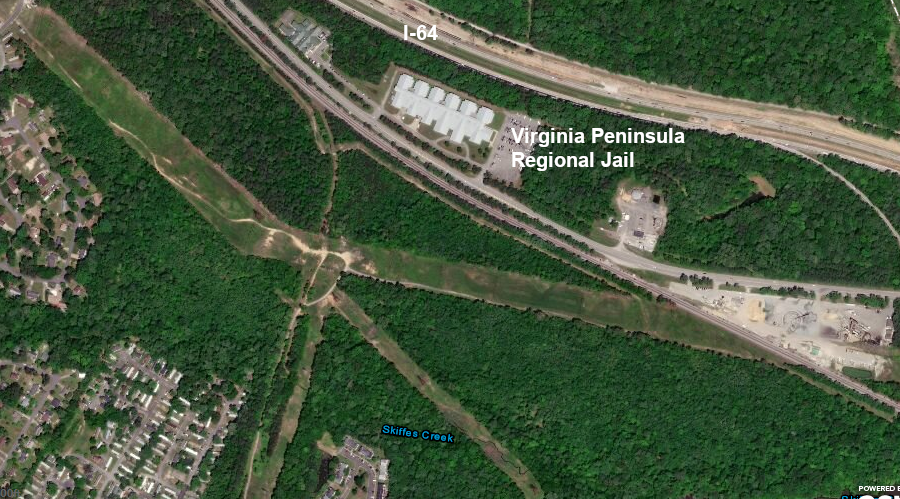
site of the Skiffes Creek substation, prior to construction
Source: ESRI, ArcGIS Online

the towers across the James River will be in the Near Horizon viewshed of Jamestown Island
Source: National Park Service, Analysis of Visual Impacts to Historic Properties
Proposed Dominion Surry-Skiffes Creek - Whealton Alternative (Figure 3 - Distance Zones)